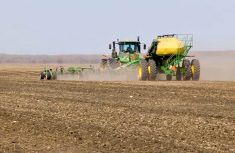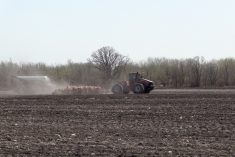While your crop rotations and your seeding practices have evolved into something your grandfather might not recognize, recommended phosphorous guidelines for Manitoba farmers haven’t changed in more than 20 years.
Over the past year, Manitoba soil fertility experts came together to fill this gap. John Heard (Manitoba Agriculture, Food and Rural Development), Cindy Grant (Agriculture and Agri-Food Canada) and Don Flaten (University of Manitoba) found low phosphorus (P) levels in soil tests in many areas across the province.
They weren’t surprised. In recent decades, yields have increased — and farmers have moved from crops that remove relatively low amounts of P from the soil (cereals, flax) to crops that use a lot more P (canola, soybeans, corn).
Read Also

The U.S. corn crop could be the biggest ever. That’s terrible news for America’s farmers.
The USDA predicts a record corn crop for U.S. farmers, who question the agency’s accuracy amidst high debt and low crop prices.
Plants need phosphorus. It contributes to photosynthesis, respiration, energy transfer, cell division, early root growth and winter hardiness.
Recommendations in place since 1992 have been based not only on outdated P needs but on a “short-term sufficiency” approach, with a goal of supplying enough P for a good yield on the current crop. The updated recommendations consider long-term soil productivity.
Flaten has a simple analogy. “A phosphorus budget works like a financial budget or bank account,” he said. “If you apply more phosphorous than you remove at harvest, that phosphorus goes into ‘savings’ as a reasonably stable and plant-available source of P for future crops.”
A long-term view of a field’s P needs provides more flexibility. Farmers can replenish P in the soil when prices are relatively low while, over time, reducing the risk that low nutrients will limit yield.
For a long-term approach, the experts point out:
- Banded phosphorus is more agronomically efficient than broadcasting.
- Sidebanding at planting is the optimum method for small seeded and solid seeded crops in Manitoba.
- Farmers without sidebanding equipment can apply higher-than-needed P rates when they’re seeding cereals that are more tolerant, applying a surplus one year to make up for a deficit in another year.
- Manure application to meet nitrogen requirements will give a field enough P for several years.
The experts’ numbers are shown in the table below, which is also included in their paper (attached here). These rates are based on three factors: your soil test results, what you’re planting and how the P will be applied.
For example, if your soil test shows an “M” for phosphorus, with 10 parts per million and 20 pounds per acre and you’re going to be placing the P with the seed, the recommended P rate for canola is 20 pounds per acre.
Long-term research
The results of a long-term AAFC phosphorus study based at Swift Current, Sask., recently turned heads. After years of applying P to the soil, researchers stopped applying P in 1995. Compared to test plots where they kept applying P, yields didn’t suffer.
The head researcher, Dr. Barbara Cade-Menun, is excited about this research into how plants use “legacy fertilizer.”
“This may or may not be typical of a farm,” Cade-Menun said. She also noted some of these results can be attributed to the higher rates of moisture in southwestern Saskatchewan in recent years.
“Compared to other parts of Saskatchewan and everywhere else, plant growth here is limited by water first, and nitrogen second, and then phosphorus.”
Flaten attributes the results of this study as the simple impact of drawing down on a long-running bank account.
“In situations like some of the long-term studies at Swift Current, the surplus phosphorus that accumulates during years of phosphorus fertilization can offset a phosphorus ‘deficit’ that occurs later on, when no phosphorus or low rates of phosphorus are applied.
“However, if no phosphorus is applied over a long period of time, even soils with a large reserve of phosphorus will become phosphorus-deficient and yields will eventually decline.”
Flaten also refers to a long-term study done by Dr. Martin Entz at the University of Manitoba’s Glenlea Research Station. Graduate student Cathy Welsh completed a long-term study of the effects of removing hay and grain from organic plots without replacing P.
“Even though soil test levels of phosphorus in this trial were very high at the beginning, after 12 years without adding any phosphorus, the decline in the most plant-available pools of phosphorus (i.e., the cash reserves in the phosphorus bank) was much more dramatic than in stable reserves (i.e., the bonds and term deposits in the phosphorus bank.)
“Then, Dr. Entz added composted beef cattle manure on half of the plots, to restore phosphorus, with a dramatic increase in crop yields.”
— Leeann Minogue is the editor of Grainews, based at Griffin, Sask. Watch for more details on this topic in the April 28, 2015 issue of Grainews.













